Archive
- Behind the Screens 9
- Bright Young Things 16
- Colour Palette 64
- Dress Ups 60
- Fashionisms 25
- Fashionistamatics 107
- Foreign Exchange 13
- From the Pages of… 81
- G.U.I.L.T. 10
- Little Trifles 126
- Lost and Found 89
- Odd Socks 130
- Out of the Album 39
- Red Carpet 3
- Silver Screen Style 33
- Sit Like a Lady! 29
- Spin, Flip, Click 34
- Vintage Rescue 20
- Vintage Style 157
- Wardrobe 101 148
- What I Actually Wore 163
Hello! I just (didn’t) step out of a time machine.
Greetings again dear readers, those of you who have emigrated with me. Apologies for the long silence as I have been very busy working on populating the professional sections of my website. (Please feel free to have a look at the portfolio.) But for those of you who are here only for the fashion, ta-da! Here is a little ‘fashionistamatic’ taken of me three weeks ago.
Since I last was consistently posting here, my personal style has evolved once more, and it is the 1930s era that I have become enamoured with. I won’t wax lyrical about it just yet, as it deserves lots of paragraphs: I’ve been thinking of writing a little series on why I think the 30s are the most stylish era EVER – perhaps a grandiose claim which will require copious justification to allay some skeptics.
I do own quite a lot of original 1930s garments and accessories, which I have bought both online from vintage boutiques or eBay, and a great many – remarkably – from op shops (thrift stores) right here in Melbourne. I have a theory that most of the volunteer staff, while au fait with 40s or 50s fashion, really do not know how to identify original 30s items because they confuse them with the 1970s. (The Thirties did have a big influence in that era too, via films such as Bonnie & Clyde.)
I’ve always said that I would hate to look like I have stepped out of a period film, or out of a time machine, and one way I have tried to maintain some semblance of modernity is by mixing eras. Hair and makeup styles help too. However, if I could have an entire wardrobe of original 30s garments, I would not hesitate to wear it head to toe, all day, every day. (1930s shoes are the most comfortable I’ve ever worn – they don’t make them like they used to!) Unfortunately, availability and cost hinder me somewhat.
Here I am wearing a 1930s straw hat trimmed with black velvet and celluloid berries, which I bought on eBay. The berries make the cutest clicking sound in my ear as I walk – like billiard balls. The blouse is modern, and the silk scarf is actually from an earlier period – the seller thought either Edwardian or even Victorian. Neckline embellishments such as collars, scarves and bows were huge in the 30s though, literally and figuratively. I’m also wearing a pair of vintage earrings (not sure of era) that match the celluloid berries really well. Those and the blouse were op shop purchases.
PS You’ll see now I’ve added a blog header, and an archive drop-down menu so you can find things a bit more easily (the section header temporarily enlarges when the menu is opened, which seems to be unavoidable). I have also transferred most if not all of the old Look Book galleries, accessible in the main navigation. Unfortunately something very weird happened to the Ten Commandments on style stories in the migration from my old site, so that is temporarily inaccessible as I will have to lay that out in its entirety afresh when I have time. Please also note that there will be some weird formatting on any posts older than this one; I will try to fix these if and when I have time, but there is ten years’ worth of blogging below here!
Marvellous Mauve
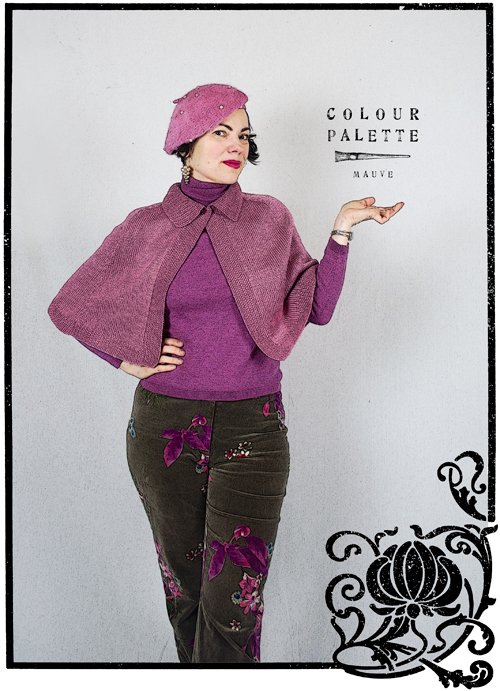 A couple of years ago I wrote a story about different shades of purple, and I touched on the discovery of the first aniline dye in 1856 that became known as mauve, the French word for mallow flower after which the colour is named. Originally it was probably a darker shade than contemporary notions of it, as it was first likened to Tyrian purple which is much darker. The first mauve dye was replaced with other synthetic dyes in 1873: a lighter, less-saturated shade that we are familiar with today. As Wikipedia succinctly describes it, ‘mauve contains more grey and more blue than a pale tint of magenta’.
A couple of years ago I wrote a story about different shades of purple, and I touched on the discovery of the first aniline dye in 1856 that became known as mauve, the French word for mallow flower after which the colour is named. Originally it was probably a darker shade than contemporary notions of it, as it was first likened to Tyrian purple which is much darker. The first mauve dye was replaced with other synthetic dyes in 1873: a lighter, less-saturated shade that we are familiar with today. As Wikipedia succinctly describes it, ‘mauve contains more grey and more blue than a pale tint of magenta’.
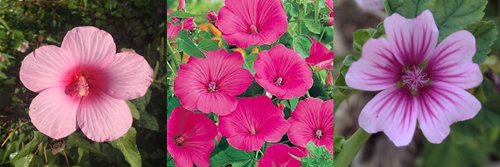 Three shades of mallow flowersHowever, while it was a synthetic dye, in the 1850s it was still quite expensive to process, and if not for Empress Eugénie, wife of Napoleon III, taking a liking to it because it supposedly exactly matched her ‘violet’ eyes, the colour might have disappeared. Queen Victoria subsequently gave it the thumbs-up, and for a time it was all the rage, reaching its heights of popularity in the 1890s.
Three shades of mallow flowersHowever, while it was a synthetic dye, in the 1850s it was still quite expensive to process, and if not for Empress Eugénie, wife of Napoleon III, taking a liking to it because it supposedly exactly matched her ‘violet’ eyes, the colour might have disappeared. Queen Victoria subsequently gave it the thumbs-up, and for a time it was all the rage, reaching its heights of popularity in the 1890s.
… for a time it was all the rage, reaching its heights of popularity in the 1890s
As with many trends, however, it soon reached over-saturation in the market and eventually it became passé, synonymous with ladies of a certain age. Even in the twentieth century, it was associated with aging, as it was one of the shades white-haired ladies chose to rinse their hair with to remove unlikable yellowish tones. Today of course that trend has been turned on its head and grey hair tinted with pastel shades is all the rage with young people!
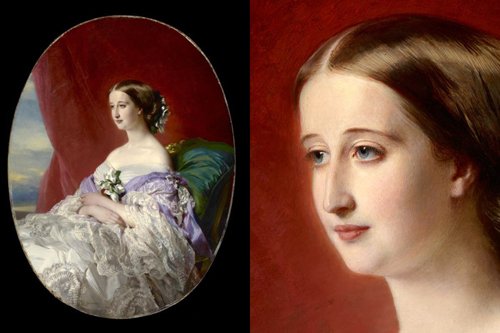 Empress Eugenie, 1854, by Franz Xaver Winterhalter – Franz clearly thought, "Pfft, purple eyes, MY EYE!"
Empress Eugenie, 1854, by Franz Xaver Winterhalter – Franz clearly thought, "Pfft, purple eyes, MY EYE!"
Wait, what about the purple eyes?
I was interested in this notion of the Empress’s supposed violet eyes, and some research lead me to learn that Elizabeth Taylor was another celebrity famed for her violet eyes. Paintings are not necessarily true to life, and photographic evidence is obviously unreliable as it is too easy to digitally enhance hues or use colour filters in-camera.
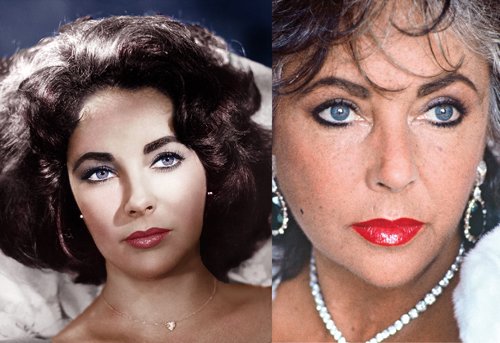 Elizabeth Taylor in 1960 (ph unknown) and 1985 (ph Helmut Newton); she definitely seems to have naturally blue eyes that have been enhanced by the colour processing in the first photoAfter a lot of reading, I can state definitely that the human eye does not naturally come in shades of purple; ie people cannot be born with it. Put simply, the colour of an iris changes depending on how much light reaches it, and can be enhanced by coloured clothing or makeup surrounding the eyes; both Empress Eugénie and Elizabeth Taylor had blue eyes: one wore purple garments, the other purple eyeshadow. [See Further Reading below]
Elizabeth Taylor in 1960 (ph unknown) and 1985 (ph Helmut Newton); she definitely seems to have naturally blue eyes that have been enhanced by the colour processing in the first photoAfter a lot of reading, I can state definitely that the human eye does not naturally come in shades of purple; ie people cannot be born with it. Put simply, the colour of an iris changes depending on how much light reaches it, and can be enhanced by coloured clothing or makeup surrounding the eyes; both Empress Eugénie and Elizabeth Taylor had blue eyes: one wore purple garments, the other purple eyeshadow. [See Further Reading below]

Back to fashion …
Since my original story, I have since found new mauve items in differing shades all from thrift stores: a merino wool jumper, a prettily hand-knitted vintage wool cape, and a vintage angora, pearl-beaded beret. The jumper is modern, but I am not sure of the age of the latter two; the beret was missing pearls when I bought it, but the cape is pristine and could be a modern knit made using a vintage pattern. My printed velvet pants are modern, by the Australian label Charlie Brown.
Scroll down and check out some more mauve outfits from the Victorian era to the present.
Further Reading
The biology behind eye colour in humans
Were Elizabeth Taylor’s eyes really violet?
But wait, Liz Taylor had double eyelashes!
Just how did Lizzie make her blue eyes look purple?
Photos: August 2019
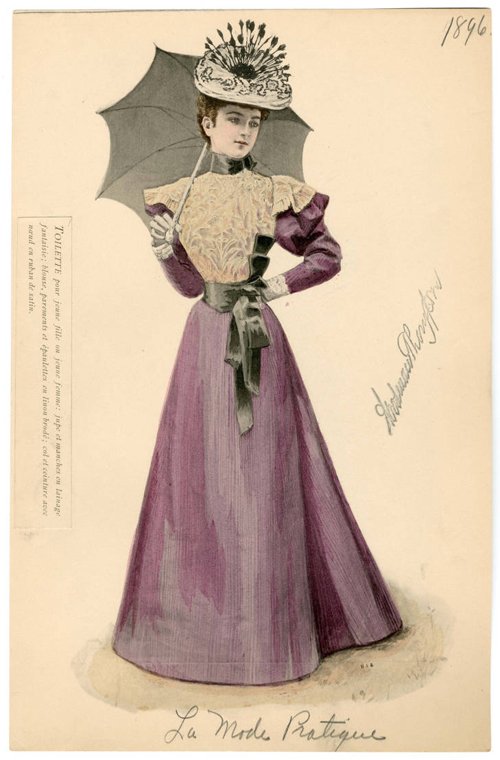 Victorian walking dress, 1896
Victorian walking dress, 1896 Victorian evening dress, 1896
Victorian evening dress, 1896 Victorian silk striped walking dress
Victorian silk striped walking dress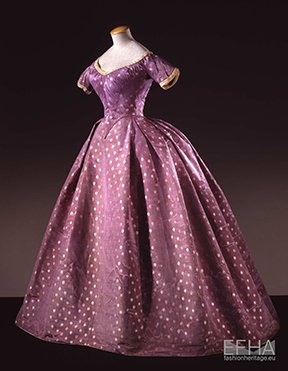 Silk taffeta evening dress, 1860-1865
Silk taffeta evening dress, 1860-1865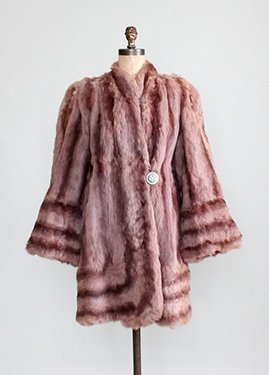 1930s fur jacket (sold)
1930s fur jacket (sold) 1930s bias gown (for sale)
1930s bias gown (for sale) 1940s catalogue – how I would love to buy this set, especially at those prices!
1940s catalogue – how I would love to buy this set, especially at those prices! Model Evelyn Tripp, wearing a dress and matching hat, ph Frances McLaughlin-Gill for Vogue
Model Evelyn Tripp, wearing a dress and matching hat, ph Frances McLaughlin-Gill for Vogue Modern outfit
Modern outfit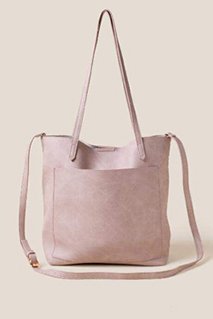 Rosie tote in mauve
Rosie tote in mauve
Of the Same Stripe
 Bathing suit, c. 1910sI love a stripe, it’s no secret. The other day while browsing on Pinterest, I spotted a nineteenth century black and white striped skirt (below) that was part of a beachwear set, and I was smitten. I would wear this off the beach today if I could but find one!
Bathing suit, c. 1910sI love a stripe, it’s no secret. The other day while browsing on Pinterest, I spotted a nineteenth century black and white striped skirt (below) that was part of a beachwear set, and I was smitten. I would wear this off the beach today if I could but find one!
 The skirt that bowled me over: Beachwear, late 1860s–early 1870sStripes are the simplest pattern of all, and when they are bold they make the most graphic and eye-catching statement. I’ll take stripes of any colour, but especially white with either black, blue, red or green.
The skirt that bowled me over: Beachwear, late 1860s–early 1870sStripes are the simplest pattern of all, and when they are bold they make the most graphic and eye-catching statement. I’ll take stripes of any colour, but especially white with either black, blue, red or green.
Here are some other amazing black and white striped garments and accessories to bowl you over.
NB All images were found on Pinterest, but where possible I have traced them to their ultimate source – click each image to jump through.
 Jacques Doucet, 1890s
Jacques Doucet, 1890s Parasol, 1897 (image originally from The Met)
Parasol, 1897 (image originally from The Met) Petticoat, c. 1900
Petticoat, c. 1900 Underskirt, c. 1900
Underskirt, c. 1900 Jeanne Lanvin, 1930s
Jeanne Lanvin, 1930s Evening dress, Madame Grès, c. 1975
Evening dress, Madame Grès, c. 1975
The Luxury Hat
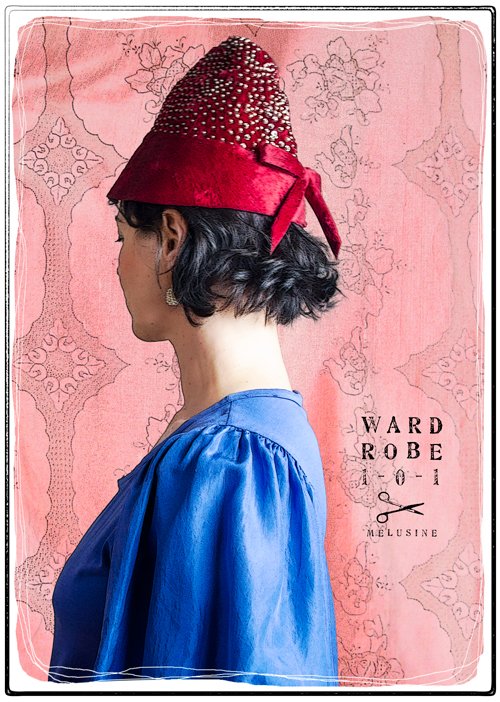 Felt is an ancient fabric, and perhaps the first made by man: it is made rather easily as it is not woven and does not require a loom. According to legend, in the Middle Ages a wandering monk named St Clement – destined to become the fourth bishop of Rome – happened upon the process of felt-making quite by accident. It is said that to make his shoes more comfortable, he stuffed them with tow (short flax or linen fibres). Walking in them on damp ground, he discovered that his own weight and sweaty feet had matted the tow fibres together into a kind of cloth. After being made bishop (with the power to indulge his whimsy), he set up a workshop to develop felting production … and thus he became the patron saint for hatmakers, who of course use felt to this day.
Felt is an ancient fabric, and perhaps the first made by man: it is made rather easily as it is not woven and does not require a loom. According to legend, in the Middle Ages a wandering monk named St Clement – destined to become the fourth bishop of Rome – happened upon the process of felt-making quite by accident. It is said that to make his shoes more comfortable, he stuffed them with tow (short flax or linen fibres). Walking in them on damp ground, he discovered that his own weight and sweaty feet had matted the tow fibres together into a kind of cloth. After being made bishop (with the power to indulge his whimsy), he set up a workshop to develop felting production … and thus he became the patron saint for hatmakers, who of course use felt to this day.
 Parisian costume, 1826
Parisian costume, 1826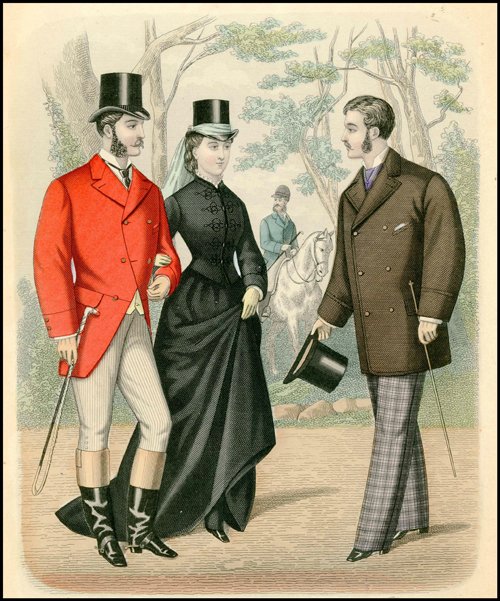 Men and women’s beaver top hats, Gentleman’s Magazine of Fashion, 1876Today most felt is made of wool, but in the past, animal fur was used to make a high-quality felt. Animal fur has tiny, microscopic spines which lock together much like Velcro when heat and moisture are applied. Beaver was the superior fur because its spines were prominent and helped produce a high-quality felt; hats made from it date back to at least the sixteenth century, and they were a staggeringly expensive luxury item. Naturally, to reduce the cost of fur felt, other furs were used such as rabbit or hare, camel, and angora (mohair).
Men and women’s beaver top hats, Gentleman’s Magazine of Fashion, 1876Today most felt is made of wool, but in the past, animal fur was used to make a high-quality felt. Animal fur has tiny, microscopic spines which lock together much like Velcro when heat and moisture are applied. Beaver was the superior fur because its spines were prominent and helped produce a high-quality felt; hats made from it date back to at least the sixteenth century, and they were a staggeringly expensive luxury item. Naturally, to reduce the cost of fur felt, other furs were used such as rabbit or hare, camel, and angora (mohair).
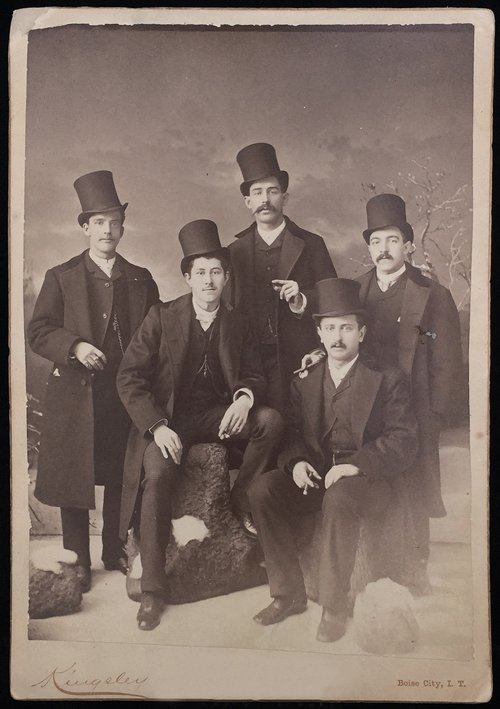 Men wearing beaver hats, 1886But it was another type of hat altogether that toppled the beaver from its luxury perch at last: the silk top hat. First invented in 1797 and scandalising the general public with its fearsome appearance, by the mid nineteenth century, the silk top hat cost half the price of beaver, and overtook it in popularity owing to changes in lifestyle which meant the hardy fur felt hats were not needed.
Men wearing beaver hats, 1886But it was another type of hat altogether that toppled the beaver from its luxury perch at last: the silk top hat. First invented in 1797 and scandalising the general public with its fearsome appearance, by the mid nineteenth century, the silk top hat cost half the price of beaver, and overtook it in popularity owing to changes in lifestyle which meant the hardy fur felt hats were not needed.
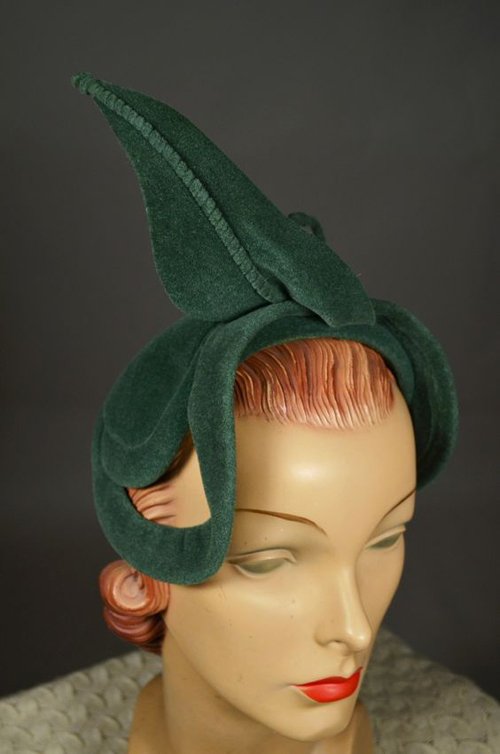 50s hat of angora fur felt; authorised reproduction of a Claude Saint-Cyr designI was initially attracted to this red 1950s pixie hat because of its dramatic shape, and the pearls (which I love) sewn all over it. It is made with Melusine, a felt made from rabbit fur. Melusine has long, fine fibres that are brushed to create a silky long-haired finish. In the past I had presumed ‘fur felt’ was a misnomer, and that such fabric was actually made from wool to look like fur. I was a bit sad when I realised this hat was real rabbit fur; however, at least it is vintage and recycled.
50s hat of angora fur felt; authorised reproduction of a Claude Saint-Cyr designI was initially attracted to this red 1950s pixie hat because of its dramatic shape, and the pearls (which I love) sewn all over it. It is made with Melusine, a felt made from rabbit fur. Melusine has long, fine fibres that are brushed to create a silky long-haired finish. In the past I had presumed ‘fur felt’ was a misnomer, and that such fabric was actually made from wool to look like fur. I was a bit sad when I realised this hat was real rabbit fur; however, at least it is vintage and recycled.
 An amazing pink fur felt reproduction Regency hat, by Jane Walton, 2019I have a few other vintage hats also made from melusine, all from the 50s and 60s. While wool felt is certainly more common these days, you can still buy new fur felt hats (some sources nebulously state the fur is a ‘by-product’) – even top hats made from beaver that are worn by top cats at Ascot – and they are still quite expensive.
An amazing pink fur felt reproduction Regency hat, by Jane Walton, 2019I have a few other vintage hats also made from melusine, all from the 50s and 60s. While wool felt is certainly more common these days, you can still buy new fur felt hats (some sources nebulously state the fur is a ‘by-product’) – even top hats made from beaver that are worn by top cats at Ascot – and they are still quite expensive.
Photo: June 2019
Did Someone Mention Giant Bows?
 Bows are practical, and bows are frivolous. From one’s shoelace, to a pussy-bow blouse, to a multitude of non-functioning bows decorating a ballgown. They just look pretty, especially when they are tied with a luxury fabric. Or they look louche, à la those blouses on the Gucci runway.
Bows are practical, and bows are frivolous. From one’s shoelace, to a pussy-bow blouse, to a multitude of non-functioning bows decorating a ballgown. They just look pretty, especially when they are tied with a luxury fabric. Or they look louche, à la those blouses on the Gucci runway.
My t-shirt is made from cotton and silk chiffon – the sleeves are so delicate and pretty. It is by Bettina Liano, an Australian label that launched in the 1980s and is famous for its denim line. I bought this tee in a thrift store, however, as I did the bow headband for amusement’s sake – I have not actually worn it out.
It is a big bow. Alas it is not quite as big as the giant bow on the Edwardian hat on the cover of Ladies Home Journal that I shared yesterday. I think I would feel more comfortable wearing an enormous bow on a hat than as a headband; or even a scarf tied in a huge bow would fit my style better.
Scroll down for a few bows of the past.
Photo: December 2016
 Mon Vignon, Paris, 1860s Bubblegum pink silk two piece, self-fabric bow trim to shoulders and skirt hem
Mon Vignon, Paris, 1860s Bubblegum pink silk two piece, self-fabric bow trim to shoulders and skirt hem Lucile afternoon dress, 1917–20
Lucile afternoon dress, 1917–20 Balenciaga, 1951
Balenciaga, 1951 Yves Saint Laurent haute couture, 1983
Yves Saint Laurent haute couture, 1983 Gucci Fall/Winter 2011-2012
Gucci Fall/Winter 2011-2012 Pussybows at Gucci Fall/Winter 2011-2012
Pussybows at Gucci Fall/Winter 2011-2012



